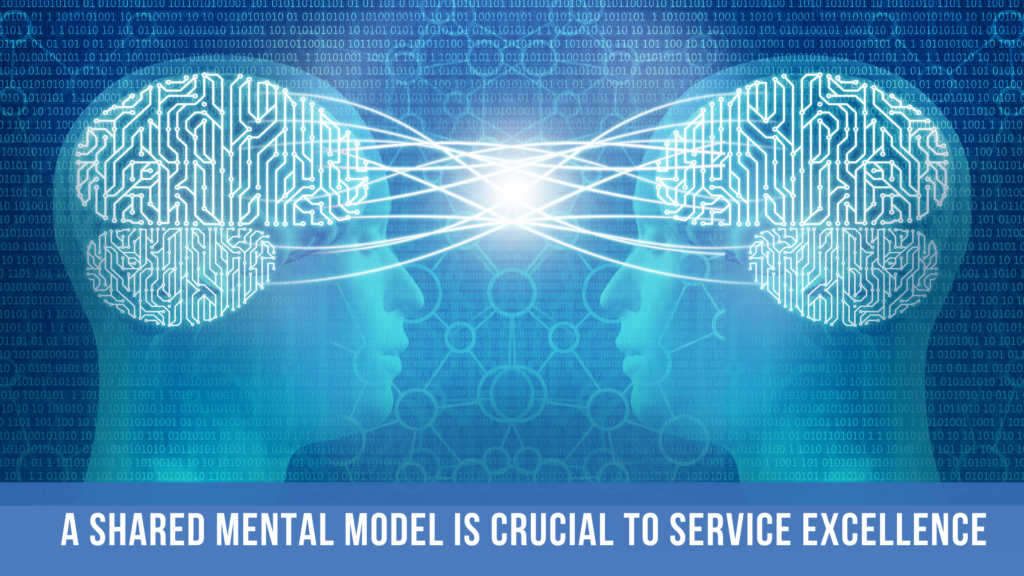If a business is not anchored to a common vision for customer experience and service excellence, it’s going to be condemning itself to a constantly shifting service delivery goal post. If you’re not sure of where the target is located, how can you hit the target? I preach constantly to business clients, that a crucial milestone in the journey to exceptional customer experience branding is establishing a vision for the endgame. A second crucial milestone is creating a shared mental model that supports the vision and to have all employees of the business embrace this model.
Have you ever marvelled at the effortlessness of synchronized swimming? Sheer magic in motion. Getting to this place of synchronicity requires the team to develop a harmonized rhythm that gives the impression that they share a single mind and mindset. Elite sports teams possess this quality as well and I find it mesmerizing. Customer-led businesses are serious about imbedding a unified view and a unified model for achieving successful customer outcomes.
When a business unifies its attitude, mindset, style and processes to deliver effective transaction outcomes consistently, it crafts itself into a brand that customers experience in a common, predictable and desirable way. The process of getting to this point of unity takes quite a bit of mental muscle, discipline and consistent effort. It’s a process that many businesses find too tedious and lengthy. My response to this impatience is that “porcelain is the result of clay going through the fire.” The result is well worth the effort and in this case, the result is a business achieving competitive advantage on the basis of exceptional customer experience branding.
Customer-led businesses are serious about imbedding a unified view and a unified model for achieving successful customer outcomes.
I can’t tell you how many businesses I encounter that want a quick fix to customer experience. They are simply not interested in expending the tremendous effort it takes to achieve a permanent solution to service excellence. So, when I have the good fortune to meet a client that says, “Let’s do what it takes to achieve the endgame,” I go to my happy place and we start with a visioning session that begins the process of building a shared mental model for service delivery.
Whilst the big picture benefits of this model are evident, let’s talk about some of the day to day benefits that may be small, but impactful. Through a shared mental model in the way that customer experience is delivered, employees become a community of practice, exhibiting a commonality in their reflexes and responses to customers. A common personality emerges, with a common language pattern and a similarity in how customer situations are managed.
Whilst all of this customer-facing cadence is taking root on the front end, the pervasiveness of the model will be showing up on the back end in the form of process improvements and the strategic use of technology to support channel delivery. The shared mindset is helping the occupants of the engine rooms to engineer solutions that enable transactions to run seamlessly, efficiently and without friction. This is why diffusing the model across the business is favoured.
When a business unifies its attitude, mindset, style and processes to deliver effective transaction outcomes consistently, it crafts itself into a brand that customers experience in a common, predictable and desirable way.
At an organizational level, a shared mental model nourishes the development of a culture that is marked by internal partnerships and a convergence of similar values. I’ve come across many businesses though, that promote “oneness” without amplifying values that promote a “We’re in this together” mindset.
Does all of this sound improbable? Well, let me say that there is no shortcut to customer success. Far too many businesses bolt out of the starting block with a faulty understanding of the rudiments of achieving service excellence. My humble suggestion is that businesses should not be seduced by quick-fix schemes that use simplistic initiatives as primary solutions to correct less-than-ideal service quality.
Getting to service excellence requires the expert co-ordination of multiple moving parts that blend mental modelling, attitude, behaviours, processes and technology into a compelling brand that’s beloved by its customers.
Through a shared mental model in the way that customer experience is delivered, employees become a community of practice, exhibiting a commonality in their reflexes and responses to customers.
If nothing else, the pandemic should have convinced businesses of the need for a service overhaul and the need to upgrade to a more multi-dimensional, customer experience playbook.
So, has your business started its customer experience shape-shifting journey?

